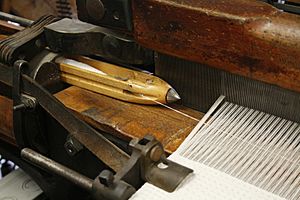Flying shuttle facts for kids
The flying shuttle is a special tool used in weaving. It was a very important invention during the early days of the Industrial Revolution. This tool made it much easier to weave wider fabrics. It also helped lead to the creation of automatic weaving machines.
The flying shuttle was invented by John Kay. He received a patent for it in 1733. This invention made the weaving process much faster than when it was done by hand. It also meant that fewer people were needed to weave cloth. Before the flying shuttle, a wide loom needed two weavers. With the flying shuttle, just one person could do the job. Also, before this invention, four people spinning thread were needed to keep one weaver busy.
By the 1750s, many people were using the flying shuttle. This caused a big change in how textiles were made. It meant that spinning thread needed to catch up with the faster weaving.
Contents
How Weaving Worked Before
To understand how amazing the flying shuttle was, let's look at how weaving worked before it. On an old loom, the weaver sat in front of the cloth being made. They used foot pedals to lift and lower some threads. These threads are called the warp threads. This action created an opening called a "shed."
Then, the weaver had to reach forward with one hand. They would pass a shuttle through this opening. The shuttle held the weft thread. Another hand would catch the shuttle on the other side. After that, the opening was closed. A part called the beater would push the weft thread into place. This whole action was called a "pick."
Weavers had to bend forward often. More importantly, throwing and catching the shuttle was hard. If the fabric was too wide (more than about 60 inches or 150 cm), it needed two weavers. They had to work together to pass the shuttle across.
How the Flying Shuttle Changed Things
The flying shuttle made weaving much easier and faster. It uses a flat board called a "race." This race runs across the front of the loom. It creates a track for the shuttle to slide on. The lower warp threads rest on this track. The shuttle then slides smoothly over them.
At each end of the race, there is a special box. This box catches the shuttle when it reaches the end. It also has a part that pushes the shuttle back for its next trip.
The flying shuttle itself is a bit different from older shuttles. Its ends are shaped like bullets and covered with metal. It often has small rollers to help it move easily. The weft thread comes out from the end of the shuttle, not the side. The thread is stored on a pirn. A pirn is a long, cone-shaped bobbin that doesn't spin. This design helps the thread unroll smoothly. Flying shuttles are also a bit heavier. This gives them enough push to travel all the way across the loom.
Impact on Society
The flying shuttle made weaving so much faster that the people spinning thread couldn't keep up! This led to the invention of new machines for spinning. First came the spinning jenny, then the waterframe. Finally, the spinning mule was invented. These machines could make strong, fine thread in large amounts. These inventions completely changed the textile industry in Great Britain.
Some people worried that the flying shuttle would take away their jobs. This led to some protests. It is sometimes said that John Kay was attacked and left England, but he actually moved to France to try and sell his looms there.
The flying shuttle also created a new safety concern. Sometimes, if it went off its path, it could fly out of the machine. This could hit and injure workers. There were many reports of injuries, especially to eyes. In the early 1900s, the British Parliament even discussed adding guards to looms to make them safer.
Why It's Not Used Much Anymore
The flying shuttle was the main way to weave commercially until the mid-1900s. But over time, newer systems started to replace it. The heavy shuttle was noisy and used a lot of energy. Also, its weight limited how fast the loom could go.
Newer looms, like projectile and rapier looms, didn't need to carry the whole bobbin of thread across. Later, air- and water-jet looms made the moving parts even lighter. While flying shuttle looms are still used for some special purposes, and old ones are still around, they are mostly replaced by modern technology.






